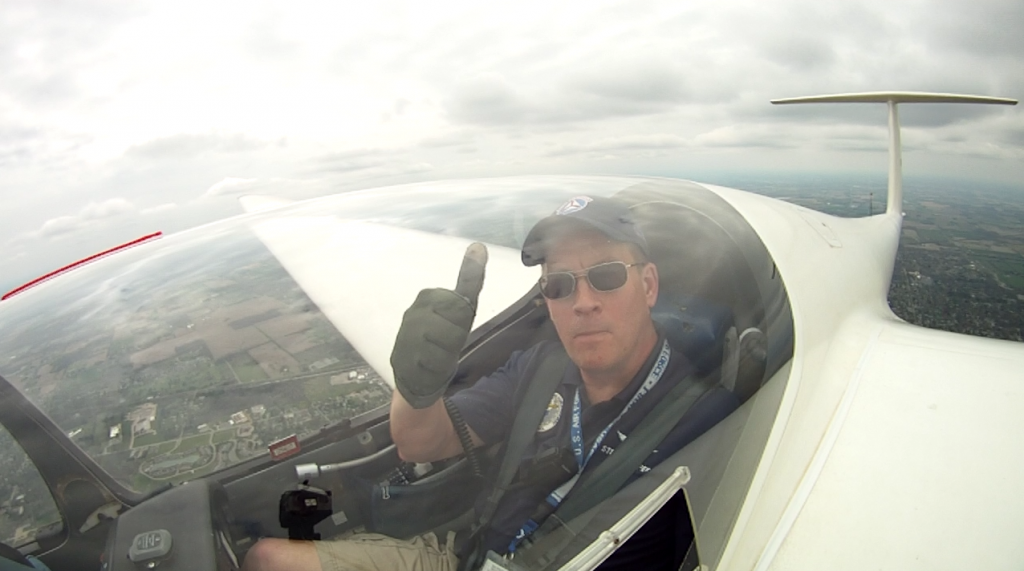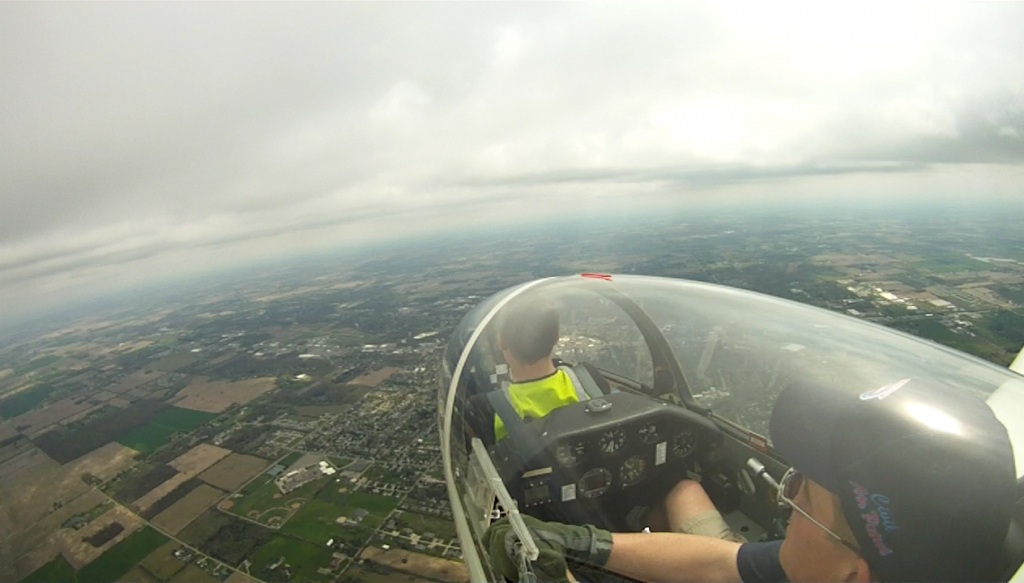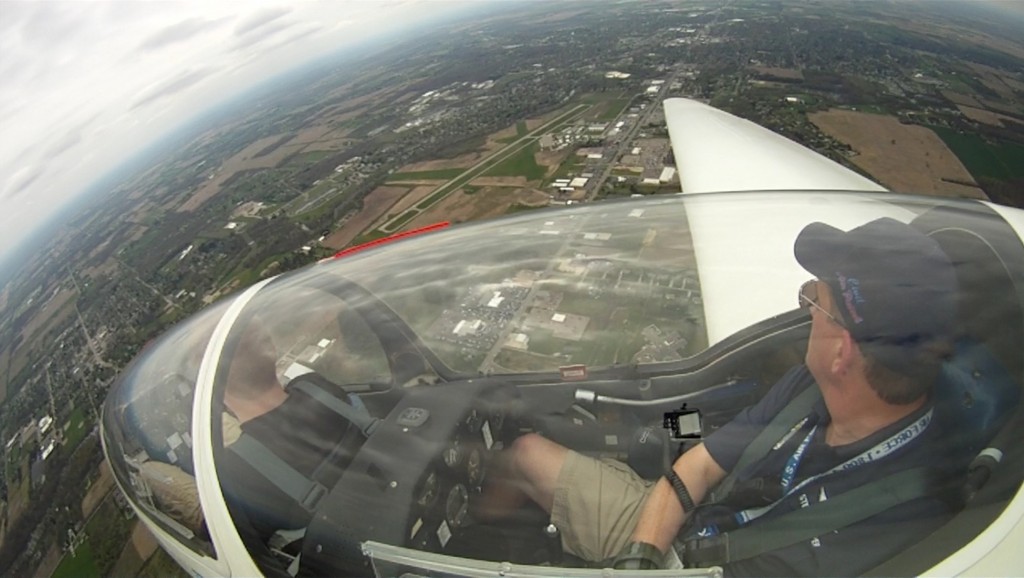Despite some pretty iffy-looking TAFs for the surrounding areas, FOD and I showed up at Owosso yesterday to find nicely flyable weather. Overcast between 5,000 and 11,000 feet, but good visibility and the even the occasional convection that allowed 2,500-foot tows to result in flights of up to 0.5 hours.
I had a few objectives for the day. Fly such cadets as were there for orientation flights, fly with a couple of cadet students, and test out the camera rig for shooting video aloft. All three missions accomplished.
A quick word about the camera rig. Actually, calling it a camera rig is a little overblown. It’s a first-generation GoPro attached to the sturdiest selfie stick I could find. The attachment is essentially lots of gaffer tape. Theres no housing on the camera so the form factor is as small as possible, creating very little drag. This helps in positioning the camera and also making sure that there’s no risk that any part of the rig could depart. I tested it using the car and it performed well driving at 70 mph (about the peak speed that I’d expect in the airflow outside the gilder.
After safety, the most important thing was testing angles and dangles. I quickly found the right vertical angle that would keep the telescoping pole out of the frame and also tested a couple of perspectives.
I think that my favorite angle is straight out the window looking back. It’s the most vertiginous and it also clearly shows both cockpit seats. Right-hand turns with good landmarks in the background (like the airport here) seem to work best. A close second is the view looking forward, like the second shot in this post. The lead shot (looking back at the rear seat) is okay, but the others are better. I want to shoot some video from the front seat as well, but I was only flying cadets yesterday and I want a qualified glider pilot in the front seat to operate the camera, so those test will have to wait.
I flew three cadets on four orientation flights: Everything from Syllabus 1 to completing one cadet’s glider O-flights with Syllabi 4 and 5. Most cadets never complete all of their O-flights. It’s becoming more common in the Michigan Wing for cadets to get all of their flights, especially their five allotted glider flights.
Probably the most satisfying part was flying cadets on C missions. Two cadets are actively training to become glider pilots and I gave dual instruction to both today. The first is a Johnson Flight Academy graduate who’s getting close to solo. He has all of the 30 flights required to solo and we’re just working on getting him to where he needs to be in order to do the solo. Flying on tow, boxing the wake, doing slack rope drills, performing all of the required maneuvers, and landing.
Probably the best part of the day was flying with the other cadet, namely my son, Nicholas “FOD” Tupper. He has about 12 hours of dual instruction (not counting the 20 or so hours or so flying the TG-7A as my guinea-pig student while training up for the CFI checkride) and 50 or so flights, of which nine are aerotows, including the three tows today. He flew very well on tow and all of his free-flight maneuvers looked good.
I demonstrated boxing the wake for him once on the second flight. On the third, I gave him the controls and let him try it. He flew the most perfect box I’ve ever seen flown by a student. Not that I’ve seen many as an instructor – I’ve only been a CFI for a year or so. But it was checkride-perfect. Really nice. I just sat in back with my arms crossed and watched.
On the last flight of the day for each glider, we usually land on Rwy 6/24 and get is stopped right next to the ramp, which makes it easier to get the glider back in the barn. For Rwy 6, that means landing on the last 1,000 feet or so of the runway, past the paved runway and taxiway. This helps with retrieval and also prevents hitting the pavement of the runway and taxiway, which feel like sidewalk curbs if you hit them while on the roll. FOD picked the aim point all by himself and got the landing very nicely in the grass.
I like the grass. I miss the grass. But Owosso’s grass runways are pretty short and a little shaggy, so operating from them isn’t an option. Takeoffs would be a little close to the trees at the end of the runway if we tried to launch from the grass and it’s not an option to land on the grass and then drag the gliders a half mile back to the launch point on Rwy 11 /29. No biggie, but I miss the grass.
Flying with both cadet students gave me another chance to work out my instructional technique and figure out what I’m doing. Both cadet students are flying very well, but have a lot to work on. They’re past the basics and neither is going to bend the aircraft, me, or themselves, so I got to work on figuring out how to get each to the next level. That’s a very different thing from flying early ab initio glider students (who have no idea what they’re doing) and it’s also different from flying with ASEL pilots (who know airplanes, but are mostly scared about making it back to the airport in a glider and don’t know how to use their feet).
I didn’t know anything about flying until I started flying in formation. Then I realized that I didn’t know anything about flying until I started instructing. I suspect that there are many more experiences that will cause similar epiphanies.
In the meantime, I had the kind of day that people envision when they decide to have kids. FOD was perfect in every way. Running wings, lining up a powered O-flight for himself (of which he flew nearly everything above 1,000 AGL), and flying the ASK 21 better than I’ve ever seen him fly anything before. I’m really proud of my son and I can’t wait to continue this journey.





Hi Steve, I am working with a flying club and we are starting a video series/blog series. I would love to chat about you doing some guest appearances. Feel free to either call or email me this week, thanks Steve.
Shannon
218-391-6963
duluthflyingclub.com
Who is flying the plane (Or paying attention) while you are mugging for the camera? Some of us fly for the CAP because there is a mission to accomplish and not because we wish to attract attention to ourselves. This stuff makes CAP look bad.
The person flying the glider (not a “plane”) is a 50+ sortie student pilot who is familiar with the aircraft, the airspace, and the instructor and his skills are well known to me. The video was shot during non-critical phases of flight with no other aircraft observed or heard in the area and after due clearing turns. As to CAP? One of its missions is to promote CAP and aviation (read: draw attention to ourselves) and the camera test is for CAP promotional materials, particularly to be considered for inclusion in a CAP national recruiting video. If one is to get cadets and other excited about flying, I think you have to admit that in-flight images and video are important or essential. Many CAP wings, and CAP NHQ, include such images in CAP promotional materials. But haters gonna hate.
That was the best ride EVER!!!!!!!!!